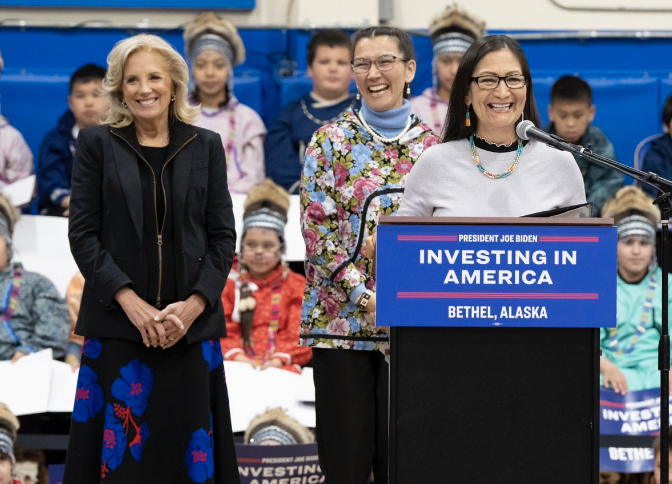
- Details
- By Levi Rickert
First Lady Dr. Jill Biden made a stop in Bethel, Alaska on her way to the G-7 Summit in Japan to meet up with her husband, President Joe Biden on Wednesday. Flying with the first lady was U.S. Department of the Interior Secretary Deb Haaland (Laguna Pueblo).
They were greeted by Rep. Mary Petola (D-AK), who is the first Alaska Native ever elected to Congress, and other local Alaska Native officials.
Dr. Biden and Secretary Haaland were there to highlight the Biden-Harris Administration's historic investments to expand broadband connectivity in Alaska, including Alaska Native communities in Alaska’s Yukon-Kuskokwim Delta.
During her remarks First Lady Biden praised Haaland’s ongoing work to protect the environment and her work with tribes across Indian Country.
Dr. Biden then touted her husband’s administration dedication to get high-speed broadband to all Americans. She talked about the bipartisan Infrastructure Act that will invest over $100 million into the Yukon-Kuskokwim Delta and even in other parts of Alaska.
"The funding is going directly to Bethel Native Corporation because you know what your communities need, and I love the name that you've chosen for it," Dr. Biden said. "An Airraq isn't the story itself. It's a tool that helps us tell it. A simple string that becomes a thing of beauty with the creativity and joy and hope we bring to it. The connections of this community are already deep. But with Airraq, you will be able to bring them to life in new ways."
She said the investment is one of the largest tribal broadband expansions in the country.
“With high-speed internet, you’ll have better access to critical health care, new educational tools, and remote job opportunities. It will change lives. It will save lives. And it will help make our world a little brighter, a little more beautiful,” Biden said.
Located in the southwest corner of Alaska, Bethel still lacks high-speed fiber connection. Currently, residents and businesses there rely on microwave transmitters on over 100 towers. The service is expensive and slow. Large files, such as medical records, are difficult to download.
More Stories Like This
Native News Weekly (August 25, 2024): D.C. BriefsUS Presidents in Their Own Words Concerning American Indians
Indigenous Actor Elaine Miles Reports Detention by Alleged ICE Agents
Happy Thanksgiving from Native News Online
Coming Up on Native Bidaské: Behind the Animation: Joey Clift Talks “Pow” and Native Storytelling
Help us tell the stories that could save Native languages and food traditions
At a critical moment for Indian Country, Native News Online is embarking on our most ambitious reporting project yet: "Cultivating Culture," a three-year investigation into two forces shaping Native community survival—food sovereignty and language revitalization.
The devastating impact of COVID-19 accelerated the loss of Native elders and with them, irreplaceable cultural knowledge. Yet across tribal communities, innovative leaders are fighting back, reclaiming traditional food systems and breathing new life into Native languages. These aren't just cultural preservation efforts—they're powerful pathways to community health, healing, and resilience.
Our dedicated reporting team will spend three years documenting these stories through on-the-ground reporting in 18 tribal communities, producing over 200 in-depth stories, 18 podcast episodes, and multimedia content that amplifies Indigenous voices. We'll show policymakers, funders, and allies how cultural restoration directly impacts physical and mental wellness while celebrating successful models of sovereignty and self-determination.
This isn't corporate media parachuting into Indian Country for a quick story. This is sustained, relationship-based journalism by Native reporters who understand these communities. It's "Warrior Journalism"—fearless reporting that serves the 5.5 million readers who depend on us for news that mainstream media often ignores.
We need your help right now. While we've secured partial funding, we're still $450,000 short of our three-year budget. Our immediate goal is $25,000 this month to keep this critical work moving forward—funding reporter salaries, travel to remote communities, photography, and the deep reporting these stories deserve.
Every dollar directly supports Indigenous journalists telling Indigenous stories. Whether it's $5 or $50, your contribution ensures these vital narratives of resilience, innovation, and hope don't disappear into silence.
 The stakes couldn't be higher. Native languages are being lost at an alarming rate. Food insecurity plagues many tribal communities. But solutions are emerging, and these stories need to be told.
The stakes couldn't be higher. Native languages are being lost at an alarming rate. Food insecurity plagues many tribal communities. But solutions are emerging, and these stories need to be told.
Support independent Native journalism. Fund the stories that matter.
Levi Rickert (Potawatomi), Editor & Publisher

